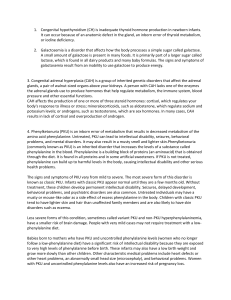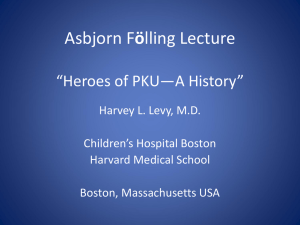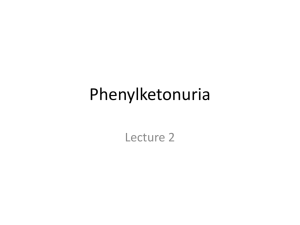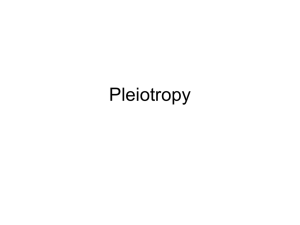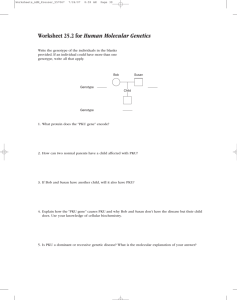Histopathological Effects on the Eye Development during Perinatal Growth of Albino Rats Maternally Treated with Experimental Phenylketonuria during Pregnancy
advertisement
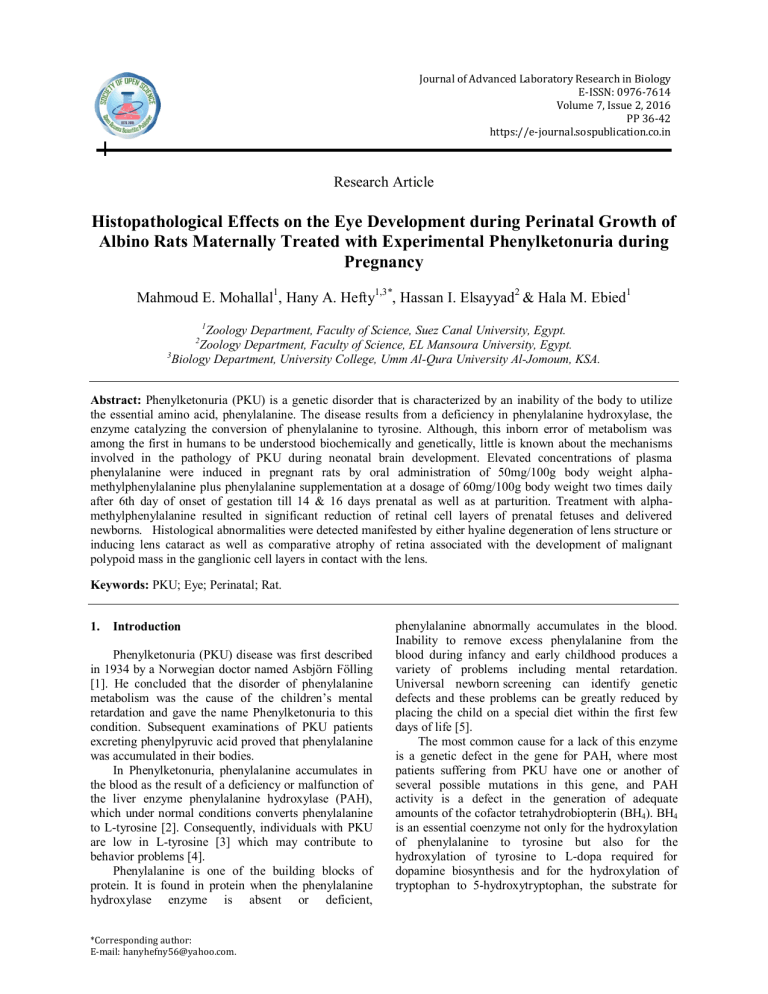
Journal of Advanced Laboratory Research in Biology E-ISSN: 0976-7614 Volume 7, Issue 2, 2016 PP 36-42 https://e-journal.sospublication.co.in Research Article Histopathological Effects on the Eye Development during Perinatal Growth of Albino Rats Maternally Treated with Experimental Phenylketonuria during Pregnancy Mahmoud E. Mohallal1, Hany A. Hefty1,3*, Hassan I. Elsayyad2 & Hala M. Ebied1 1 Zoology Department, Faculty of Science, Suez Canal University, Egypt. Zoology Department, Faculty of Science, EL Mansoura University, Egypt. 3 Biology Department, University College, Umm Al-Qura University Al-Jomoum, KSA. 2 Abstract: Phenylketonuria (PKU) is a genetic disorder that is characterized by an inability of the body to utilize the essential amino acid, phenylalanine. The disease results from a deficiency in phenylalanine hydroxylase, the enzyme catalyzing the conversion of phenylalanine to tyrosine. Although, this inborn error of metabolism was among the first in humans to be understood biochemically and genetically, little is known about the mechanisms involved in the pathology of PKU during neonatal brain development. Elevated concentrations of plasma phenylalanine were induced in pregnant rats by oral administration of 50mg/100g body weight alphamethylphenylalanine plus phenylalanine supplementation at a dosage of 60mg/100g body weight two times daily after 6th day of onset of gestation till 14 & 16 days prenatal as well as at parturition. Treatment with alphamethylphenylalanine resulted in significant reduction of retinal cell layers of prenatal fetuses and delivered newborns. Histological abnormalities were detected manifested by either hyaline degeneration of lens structure or inducing lens cataract as well as comparative atrophy of retina associated with the development of malignant polypoid mass in the ganglionic cell layers in contact with the lens. Keywords: PKU; Eye; Perinatal; Rat. 1. Introduction Phenylketonuria (PKU) disease was first described in 1934 by a Norwegian doctor named Asbjörn Fölling [1]. He concluded that the disorder of phenylalanine metabolism was the cause of the children’s mental retardation and gave the name Phenylketonuria to this condition. Subsequent examinations of PKU patients excreting phenylpyruvic acid proved that phenylalanine was accumulated in their bodies. In Phenylketonuria, phenylalanine accumulates in the blood as the result of a deficiency or malfunction of the liver enzyme phenylalanine hydroxylase (PAH), which under normal conditions converts phenylalanine to L-tyrosine [2]. Consequently, individuals with PKU are low in L-tyrosine [3] which may contribute to behavior problems [4]. Phenylalanine is one of the building blocks of protein. It is found in protein when the phenylalanine hydroxylase enzyme is absent or deficient, *Corresponding author: E-mail: hanyhefny56@yahoo.com. phenylalanine abnormally accumulates in the blood. Inability to remove excess phenylalanine from the blood during infancy and early childhood produces a variety of problems including mental retardation. Universal newborn screening can identify genetic defects and these problems can be greatly reduced by placing the child on a special diet within the first few days of life [5]. The most common cause for a lack of this enzyme is a genetic defect in the gene for PAH, where most patients suffering from PKU have one or another of several possible mutations in this gene, and PAH activity is a defect in the generation of adequate amounts of the cofactor tetrahydrobiopterin (BH4). BH4 is an essential coenzyme not only for the hydroxylation of phenylalanine to tyrosine but also for the hydroxylation of tyrosine to L-dopa required for dopamine biosynthesis and for the hydroxylation of tryptophan to 5-hydroxytryptophan, the substrate for Effect of Phenylketonuria on the on the eye development of Albino Rats serotonin biosynthesis. This group appears to constitute 3% of all hyperphenylalaninemia patients [6]. Genetic analysis, using recombinant DNA techniques, has established that the genetic locus for PKU is on chromosome 12, DNA analysis has shown that the classical form of the disease is due not to deletion of the entire gene for PAH, but is instead due to mutations within the gene's sequence leading to amino acid substitutions; results in an enzyme that does not work properly and therefore the body cannot metabolize phenylalanine (Pietz, 1998). The gene for PAH was cloned in [7], and by now more than 400 different mutations in the PAH gene have been identified [8, 9]. Excessively, high or low levels of phenylalanine may occur during pregnancy, both of which may adversely affect the fetus [10]. Maternal PKU can lead to fetal malformations, mental retardation [11]. Adverse effects on the offspring can be reduced by family planning and by careful dietary control both prior to and during pregnancy [12]. In addition, low Ltyrosine levels in pregnant women with PKU may contribute to fetal damage [13]. Untreated children with persistent severe hyperphenylalaninemia (Elevated plasma Phe concentration; HPA) show impaired brain development and behavior problems. The excretion of excessive phenylalanine and its metabolites can create a mousy body odor, sensitivity to sunlight and skin conditions such as eczema [14, 15]. The associated inhibition of tyrosinase is responsible for decreased skin and hair pigmentation, light skin. Affected individuals also have decreased myelin formation and dopamine, norepinephrine, and serotonin production. Further problems can emerge later in life and include exaggerated deep tendon reflexes and paraplegia or hemiplegia [14, 15]. The aim of the present work is to clarify the adverse effects of PKU on the development of optic region during prenatal life at 14 days of gestation and at parturition. 2. Materials and methods 2.1. Experimental animals Fifty fertile virgin females and fertile males of albino rats with an average body weight of 100–110 grams (ratio of 1 male: 4 females) were obtained from Helwan Animal Breeding Farm and used for experimentation. Rats were housed in cages in the Animal House of Department of Zoology, Faculty of Science, Suez Canal University at ratio of four/cage. They were maintained at a temperature of 20–25°C with 12h light- 12h dark cycle and stayed for acclimatization for one week before starting the experiments. They were fed on standard diet composed of 50% grinding barley, 10% grinding Yellow Maize, 20% milk, and 10% vegetables. Barley is an economical nutrient source that should be strongly considered in formulating ratios for dairy animals [16]. J. Adv. Lab. Res. Biol. Hefny et al Water and food were available for consumption ad libitum throughout the experimental period. Rats were observed daily and only healthy animals were used in these experiments. 2.2. Experimental work Mating was carried out by housing females’ rats with fertile males in separate cages at a ratio of three females with one male for an overnight between 8 PM to 8 AM. The presence of vaginal blogs or the presence of sperms in the vaginal smear determined the zero date of gestation. The pregnant mothers were divided into two main groups, twenty animals per each: i. Control: Twenty pregnant mothers were divided into two subgroups ten animals in each; sacrificed at 14th and 16th day of gestation as well as at parturition. ii. Experimental Phenylketonuria group: Each selected pregnant females at the 6th day of gestation was intragastrically administered 30mg DL–αmethylphenylalanine/100g body weight, the applied dose was selected according to Rech et al., [17]. The twenty pregnant mothers diseased with experimental PKU were divided into two subgroups ten animals in each; sacrificed at 14th day of gestation as well as at parturition. 2.3. Investigated parameters The optic regions were separated from control and experimental diseased group at 14 days fetuses and delivered newborns to observe the manifestation of growth defects. The previously mentioned specimens were then washed several times in tap water, dehydrated in ascending grades of ethyl alcohol, cleared in terpineol for two days, then washed in benzene for 10 minutes and embedded in three changes of molten paraplast 5862°C. Serial 6µ thick histological sections were cut and stained in hematoxylin and eosin (Harris HX) [18], examined carefully under bright field light microscopy and photographed. 2.4. Statistical analysis Statistics were calculated with SPSS for Windows version 13.0. The means value obtained in the different groups were compared by paired student's t-test. All results were expressed as mean values ± SE and significance was defined as p<0.05 and highly significant when <0.01 [19]. 3. Results 3.1. Morphometric observation of the Eye In the observation of the morphometric assessments of retina thickness (µm) of fourteen -day fetuses and delivered newborns of experimentally induced PKU mothers, the results showed that both 14day fetuses and delivered newborns of PKU mothers 37 Effect of Phenylketonuria on the on the eye development of Albino Rats exhibited a marked reduction of retinal thickness compared with control (Table 1). Table 1. The thickness of retina (µm) of fourteen-day fetuses and delivered newborns of control and experimentally induced PKU mothers. Statistical parameter Mean ±S.D. ±S.E. T. Test P. Value Significance 14-Days Prenatal Control PKU 65.7 52.76 3.93 2.94 1.75 1.31 2.36 .0006 s Delivered newborn Control PKU 78.25 62 9.22 2.54 4.12 1.14 2.57 .0012 s S.D. = Standard deviation; S.E. = Standard error; P = Probability; S = Highly significant (p<0.01). 3.2. Histological observation In control, eye of fourteen-day fetuses showed normal pattern of cornea, lens, and retina. The retina is formed mainly of three cell layers. The outermost layer in the retina is pigmented epithelium followed by the photoreceptor cell layers (rods and cones). Another layer still undifferentiated (Plate 1: A, B, C, and D). The optic regions of experimental diseased group at 14 days fetuses showed various histological Hefny et al abnormalities. Lens exhibited widespread vesicles and vacuoles. Much spotty degenerated area appeared. Massive pyknotic cell death appeared throughout epithelial cells lining the lens. Retina exhibited considerable atrophy. Ganglionic cell layers appear degenerated. Photoreceptor cells possessed either pyknotic or karyolytic nuclei. The photoreceptor cell layers exhibited massive vacuolar degeneration and pyknosis in most nuclei (Plate 2: A, B, C, and D). In control delivered newborns, the lens attained a considerable growth and differentiation. The retina is composed of many layers from the outside inwards; the pigmented epithelium, the photoreceptor, outer nuclear, outer plexiform, inner plexiform, inner nuclear and the innermost layer of the retina, the ganglionic cell layer appears degenerated (Plate 3: A, B, C, and D). In newborns of experimentally induced PKU mother, there was a considerable swelling and degeneration of lens fibers enclosed almost. The retinal cell layers attained a considerable atrophy. The ganglionic cell layers appeared sloughing and degenerated. Different zones of degenerated photoreceptor cell layers were detected. In some specimens, the retinal cell layer detached and formed polyploid tumor masses projected toward the lens (Plate 4: A, B, C, and D). Plate 1(A – D). Photomicrographs of histological sections of eye region of control 14th days fetuses showing, normal pattern of cornea, lens, and retina. The retina formed of pigmented epithelium (pe), photoreceptor cell layer (ph) and ganglionic cell layer (g) and other layers were still undifferentiated (A: X 40-B: X 100-C: X 400). J. Adv. Lab. Res. Biol. 38 Effect of Phenylketonuria on the on the eye development of Albino Rats Hefny et al Plate 2(A - C). Photomicrographs of histological sections of eye region of 14-days fetuses of experimentally induced PKU mother showing, widespread of vesicles, vacuoles and degeneration appeared throughout epithelial cells lining the lens. Retina exhibited considerable atrophy with degenerated ganglionic cell layer (g). Photoreceptor cells (ph) possessed either pyknotic (py) or karyolytic (kl) nuclei (A: X 40 – B: X 100 – C: X 400). Plate 3(A - D). Photomicrographs of histological sections of eye region of control offsprings showing, normal characteristic pattern of both lens and retina. The retina showed differentiated cell layers; the photoreceptor (ph) outer plexiform (opl), outer nuclear (onl), inner plexiform (ipl), inner nuclear (inl) and ganglionic cell layer (A:X 40 – B:X 100- C: X 200 – D:X 400). J. Adv. Lab. Res. Biol. 39 Effect of Phenylketonuria on the on the eye development of Albino Rats Hefny et al Plate 4(A - D). Photomicrographs of histological sections of eye region of offsprings of experimentally induced PKU mother showing, massive degeneration of the lens with peculiar spongy fibrotic characteristic appearance manifesting cataract formation. The lens fibers appeared sloughing and degenerated. The retina attains a considerable atrophy with massive degeneration of their cell layer content. A striking formation of polyp projected toward the lens (A: X 40 – B: X 40 – C: X 100- D: X 400). 4. Discussion Phenylketonuria (PKU) is an inherited metabolic disease, carried through a "recessive" gene. Phenylalanine hydroxylase deficiency is caused by mutations in the PAH gene, resulting in a primary deficiency of the liver enzyme phenylalanine hydroxylase (PAH) [20-22], and consequently interrupt the conversion of amino acid phenylalanine to another amino acid tyrosine, that results in excessive accumulation of the amino acid phenylalanine and reduced levels of the amino acid L-tyrosine in the blood [23]. Thus, phenylalanine accumulates in the blood to a concentration sufficiently high to activate an alternative pathway of degeneration [24, 25]. Attempts to reveal the adverse effects of PKU on the growth of optic region during prenatal life at 14 days of gestation and at parturition understand the underlying cause for the abnormalities associated with maternal PKU have led to the use of animal model in which the histopathological investigations were encountered in optic region to clarify the disease pattern [25]. Exposure to the mother’s metabolic abnormalities affects the fetus during the entire pregnancy. The abnormalities produced by the PKU mothers are not genetic, but "Intrauterine Environmental." Our results and those of others confirm this hypothesis. Jervis [26] stated that the damage to the children of PKU mothers J. Adv. Lab. Res. Biol. is not a genetic consequence (although the children will be at least heterozygous, as PKU is an autosomal recessive disorder). This can be proven by the fact that PKU fathers produce normal offsprings [27] and also that well-controlled pregnant PKU mothers can produce children without obvious handicap. Above symptoms result from high Phe concentrations in the blood of the fetus. It is a consequence of intrauterine Phe excess resulting from the positive transplacental Phe gradient. To keep fetal blood Phe below 500µmol/l, maternal concentration should be below 300µmol/l [28, 29]. Austic and Grau [30] used the yolk sac perfusion technique whereby the yolk of embryos is replaced by defined media to study the effect of Phe and Tyr deficiency on 4-7 day old chick embryos. Both deficiencies resulted in severe degeneration of the neural retina and brain, scattered pyknosis in the spinal cord and cranial and spinal ganglia, and vacuolization of the lens in the region of lens fiber development. With the exception of the lens, the effects of Phe and Tyr deficiency appeared to be restricted to tissues of neural origin. In an experiment conducted to determine the ability of Phe to substitute for Tyr, the addition of Phe to the perfusion medium not only failed to relieve the symptoms of Tyr deficiency, but it caused a reduction of eye pigmentation, which caused by the inability of chick embryos to convert Phe to Tyr. 40 Effect of Phenylketonuria on the on the eye development of Albino Rats Andersen et al., [31] reproduced the biochemical features of PKU in developing rat pups by administering to them a combination of p-chloro-DLphenylalanine plus L-phenylalanine for the first 21 days after birth. During the treatment period, the experimental animals show delayed eye opening and significantly decreased brain and body weight compared with controls given saline. Neuropathological examination of developing animals reveals deficient myelination and some inhibition of cerebellar maturation. Rats treated with p-chloro-DLphenylalanine plus L-phenylalanine during the vulnerable period of rapid brain development, thus have enduring behavioral changes that persist throughout life. Wen et al., [32] indicated that the suckling rat treated with phenylacetate should be a useful new model for studying the pathogenesis of PKU and neuronal development. Both cerebellar and retinal neurons of postnatally treated rats are vulnerable to the adverse effects of phenylacetate. Morphological changes observed in the cerebellum, retina, and optic nerve of treated animals during the fourth to twentyfirst days of life consist of regional reductions in the size of cerebellar vermis lobules IV, V, VI, and IX, 35 to 40% reduction in thickness of the molecular layer, accumulation of cerebellar external granular cells and retinal neuroballistic cells, fewer parallel fibers in the cerebellar cortex, and few myelinated axons in the optic nerve. Diamond and Herzberg [33] recorded impaired sensitivity to visual contrast in 12 children with Phenylketonuria aged 5.4-9.8 years, despite early and continued treatment and despite phenylalanine levels within acceptable limits. They interpreted these findings as support for Diamond's hypothesis that moderately elevated plasma Phe levels (3-5x normal), combined with reduced plasma tyrosine, moderately reduce the levels of Tyr reaching the eye and brain, which adversely affects those dopamine neurons that fire and turn over dopamine most rapidly (the dopamine neurons in the retina and those projecting to prefrontal cortex). This would lead to the deficit in contrast sensitivity found here and to the selective deficit in prefrontal cortex cognitive functions previously reported in PKU children under moderately good dietary control. Recognizing that a phenylalanine diet, low in the LC-PUFA’s is necessary for cell membrane formation and normal brain and visual development, Agostoni et al., [34] examined the effects of a 12-month supplementation of LC-PUFA’s on fatty acid composition of erythrocyte lipids and visual evoked potentials in children with well-controlled PKU. The children who received supplementation showed a significant increase in docosahexaenoic acid levels of erythrocyte lipids and improved visual function. J. Adv. Lab. Res. Biol. Hefny et al Disturbance of phenylalanine metabolism interferes with the formation of unusual metabolites causing adverse effects of the development of eye regions either directly or via its effects on dopamine’s, which reproduce the cytotoxicity manifested in both retina and lens [22]. References [1]. Fölling, A. (1934). Über Ausscheidung von Phenylbrenztraubensäure in den Harn als Stoffwechselanomalie in Verbindung mit Imbezillität. Hoppe Seylers Z. Physiol. Chem., 227:169—176. [2]. Pietz, J. (1998). Neurological aspects of adult phenylketonuria. Curr. Opin. Neurol., 11: 679–88. [3]. Roberts, S.A., Thorpe, J.M., Ball, R.O. and Pencharz, P.B. (2001). Tyrosine requirement of healthy men receiving a fixed phenylalanine intake determined by using indicator amino acid oxidation. Am. J. Clin. Nutr., 73(2):276-82. [4]. Tam, S.Y. and Roth, R.H. (1997). Mesoprefrontal dopaminergic neurons: can tyrosine availability influence their functions? Biochem. Pharmacol., 53(4):441-53. [5]. Recommendations on the dietary management of phenylketonuria. Report of Medical Research Council Working Party on Phenylketonuria (1993). Archives of Disease in Childhood, 68(3), 426-7. [6]. Kaufman, S., Kapatos, G., Rizzo, W.B., Schulman, J.D., Tamarkin, L., Van Loon, G.R. (1983). Tetrahydropterin therapy for hyperphenylalaninemia caused by defective synthesis of tetrahydrobiopterin. Ann. Neurol., 14(3): 308-15. [7]. Robson, K.J., Chandra, T., MacGillivray, R.T., Woo, S.L. (1982). Polysome immunoprecipitation of phenylalanine hydroxylase mRNA from rat liver and cloning of its cDNA. Proc. Natl. Acad. Sci. USA, 79: 4701-4705. [8]. Zschocke, J. (2003). Phenylketonuria mutations in Europe. Hum. Mutat., 21(4):345-56. [9]. Scriver, C.R., Hurtubise, M., Konecki, D., Phommarinh, M., Prevost, L., Erlandsen, H., Stevens, R., Waters, P.J., Ryan, S., McDonald, D., Sarkissian, C. (2003). PAHdb 2003: what a locusspecific knowledgebase can do. Hum. Mutat., 21:333-44. [10]. Brenton, D.P. and Lilburn, M. (1996). Maternal phenylketonuria. A study from the United Kingdom. Eur. J. Pediatr., 155 Suppl 1:S177-80. [11]. Koch, R., Hanley, W., Levy, H., Matalon, R., Rouse, B., Trefz, F., Guttler, F., Azen, C., Friedman, E., Platt, L., de la Cruz, F. (2000). Maternal phenylketonuria: An international study. Mol. Genet. Metab., 71(1-2):233-9. 41 Effect of Phenylketonuria on the on the eye development of Albino Rats [12]. Rouse, B., Azen, C., Koch, R., Matalon, R., Hanley, W., de la Cruz, F., Trefz, F., Friedman, E., Shifrin, H. (1997). Maternal Phenylketonuria Collaborative Study (MPKUCS) offspring: facial anomalies, malformations, and early neurological sequelae. Am. J. Med. Genet., 69(1): 89-95. [13]. Rohr, F.J., Lobbregt, D. and Levy, H.L. (1998). Tyrosine supplementation in the treatment of Maternal Phenylketonuria. Am. J. Clin. Nutr., 67: 473-6. [14]. Pietz, J., Dunckelmann, R., Rupp, A., Rating, D., Meinck, H.M., Schmidt, H., Bremer, H.J. (1998). Neurological outcome in adult patients with earlytreated Phenylketonuria. Eur. J. Pediatr., 157(10):824-30. [15]. Williams, K. (1998). Benefits of normalizing plasma phenylalanine: impact on behavior and health. A case report. J. Inherit. Metab. Dis., 21: 785-90. [16]. Christen, S.D., Hill, T.M., Williams, M.S. (1996). Effects of tempered barley on milk yield, intake, and digestion kinetics of lactating Holstein cows. J. Dairy Sci., 79: 1394-1399. [17]. Rech, V.C., Feksa, L.R., Dutra-Filho, C.S., Wyse, A.T., Wajner, M. and Wannmacher, C.M. (2002). Inhibition of the mitochondrial respiratory chain by phenylalanine in rat cerebral cortex. Neurochem. Res., 27: 353–357. [18]. Drury, R.A. and Wallington, E.A. (1980). Carleton's Histological Technique. 5th Edition, Oxford University Press, New York. [19]. Field, A.P. (2000). Discovering statistics using SPSS for Windows: Advanced techniques for the beginner. London: Sage Publications. [20]. Jervis, G.A., Block, R.J., Bolling, D. and Kanze, E. (1940). Chemical and Metabolic Studies on Phenylalanine. II. The Phenylalanine Content of the Blood and Spinal Fluid in Phenylpyruvic Oligophrenia. J. Biol. Chem., 134: 105-113. [21]. Jervis, G.A. (1953). Phenylpyruvic oligophrenia deficiency of phenylalanine-oxidizing system. Proc. Soc. Exp. Biol. Med., 82: 514-515. [22]. Scriver, C.R. and Kaufman, S. (2001). Hyperphenylalaninemia: phenylalanine hydroxylase deficiency. In: Scriver, C.R., Beaudet, A.L., Sly, S.W., Valle, D., eds; Childs, B., Kinzler, K.W., Vogelstein, B. assoc eds. The Metabolic and Molecular Bases of Inherited Disease. 8 ed. New York, NY: McGraw-Hill; 1667-724. [23]. Diamond, A. (1996). Evidence for the importance of dopamine for prefrontal cortex functions early J. Adv. Lab. Res. Biol. Hefny et al [24]. [25]. [26]. [27]. [28]. [29]. [30]. [31]. [32]. [33]. [34]. in life. Philos. Trans. R. Soc. Lond. B. Biol. Sci., 351(1346):1483-93. Wurtman, R.J. and Wurtman, J.J. (1979). Toxic effects of food constituents on the brain. In: Guroff, G. (ed.). Nutrition and the Brain, Vol. 4. New York: Raven Press, 29–78. Gazit, V., Ben-Abraham, R., Pick, C.G., Katz, Y. (2003). beta-Phenylpyruvate induces long-term neurobehavioral damage and brain necrosis in neonatal mice. Behav. Brain Res., 143(1):1-5. Jervis, G.A. (1939). The Genetics of Phenylpyruvic Oligophrenia: A Contribution to the Study of the Influence of Heredity on Mental Defect. Journal of Mental Science, (85): 719-762. Fisch, R.O., Matalon, R., Weisberg, S., Michals, K. (1991). Children of fathers with phenylketonuria: An international survey. J. Pediatr., 118: 739-741. Gardiner, R.M. (1990). Transport of amino acids across the blood-brain barrier: Implications for treatment of maternal phenylketonuria. J. Inherit. Metab. Dis., 13: 627-33. Schoonheyta, W.E., Clarkea, J.T.R., Hanley, W.B., Johnsonb, J.M., Lehotay, D.C. (1994). Feto-maternal plasma phenylalanine concentration gradient from 19 weeks gestation to term. Clinica Chimica Acta, 225(2): 165-169. Austic, R.E. and Grau, C.R. (1971). Degeneration of the eyes and central nervous system of chick embryos subjected to phenylalanine or tyrosine deficiency. Dev. Biol., 25: 159-175. Andersen, A.E., Rowe, V. and Guroff, G. (1974). The Enduring Behavioral Changes in Rats with Experimental Phenylketonuria. Proc. Natl. Acad. Sci., 71(1): 21-5. Wen, G.Y., Wisniewski, H.M., Shek, J.W., Loo, Y.H., Fulton, T.R. (1980). Neuropathology of phenylacetate poisoning in rats: an experimental model of Phenylketonuria. Ann. Neurol.; 7(6): 557-66. Diamond, A. and Herzberg, C. (1996). Impaired sensitivity to visual contrast in children treated early and continuously for PKU. Brain, 119 (Pt 2): 523-38. Agostoni, C., Massetto, N., Biasucci, G., Rottoli, A., Bonvissuto, M., Bruzzese, M.G., Giovannini, M., Riva, E. (2000). Effects of long-chain polyunsaturated fatty acid supplementation on fatty acid status and visual function in treated children with hyperphenylalaninemia. J. Pediatr., 137: 504-509. 42

